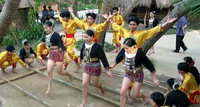| Intangible Cultural Heritage Expo opens in Chengdu |
An intangible cultural heritage expo has opened in Chengdu, capital of southwest China's Sichuan province. Exhibits from around the country are being shown at the expo, which has grown considerably in scale and offers more interactive activities and on-the-spot demonstrations. The displays prompt many to capture the scene with their cameras. The distinctly regional features being displayed set each of provincial booths apart. On the spot demonstrations are available, such as engraving a pair of scissors, to show the complicated craftsmanship involved. Though most of the artworks are handicrafts, recipes for some local foods are also on the intangible cultural heritage list. Cooking of the Huma cake, for example, attracts a curious crowd. One of the largest demonstrations at the expo goes to the craft of Sichuan style Embroidery, or the Shu Embroidery. One of the four renowned embroidery styles in China, Shu Embroidery made an early entry into the National Intangible Cultural Heritage list. But it had nearly disappeared for very few people knew the craft. Chen Xiaoya, artist, said, "The Shu Embroidery employs over a hundred ways of stitching, thirty of which are in regular use. Young people, who are often restless, are reluctant to take on the craft." Shu Embroidery dates back more than three thousand years, and was often handed down in family workshops. In recent years, the complicated technique is being done using computerized patterns. The local government is trying to reverse that trend and offers courses in primary and middle schools in Anjing County, the birthplace of Shu Embroidery. Training courses for young people are also available, with related job offerings topping six-thousand. The government has allocated over 20 million yuan RMB for the establishment of the largest gallery for Shu Embroidery in history. The gallery opened during the Intangible Cultural Heritage Festival in Chengdu. Editor: Wang Nan |
|

